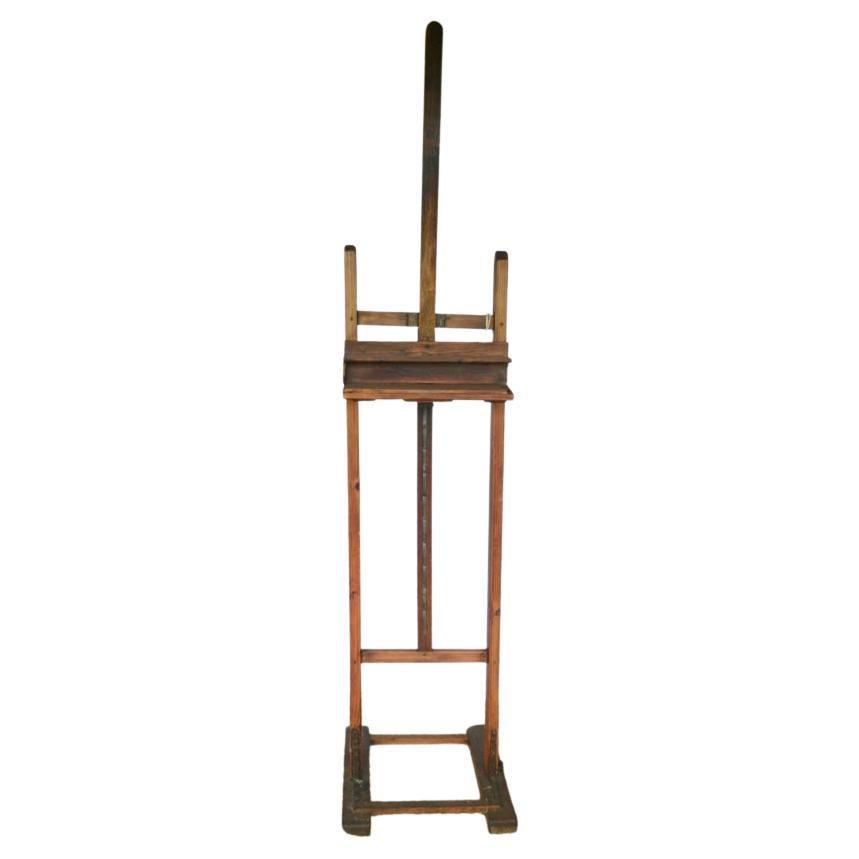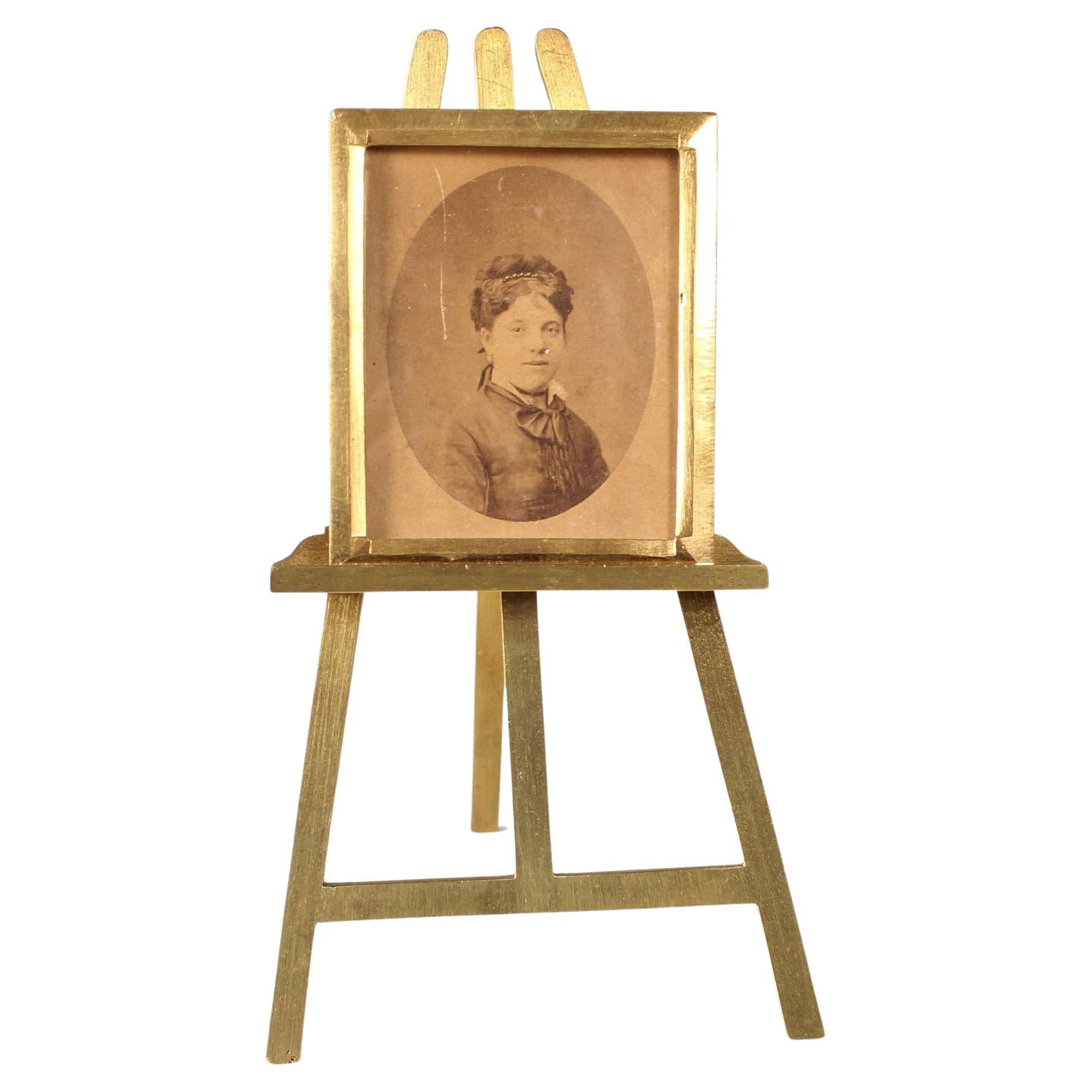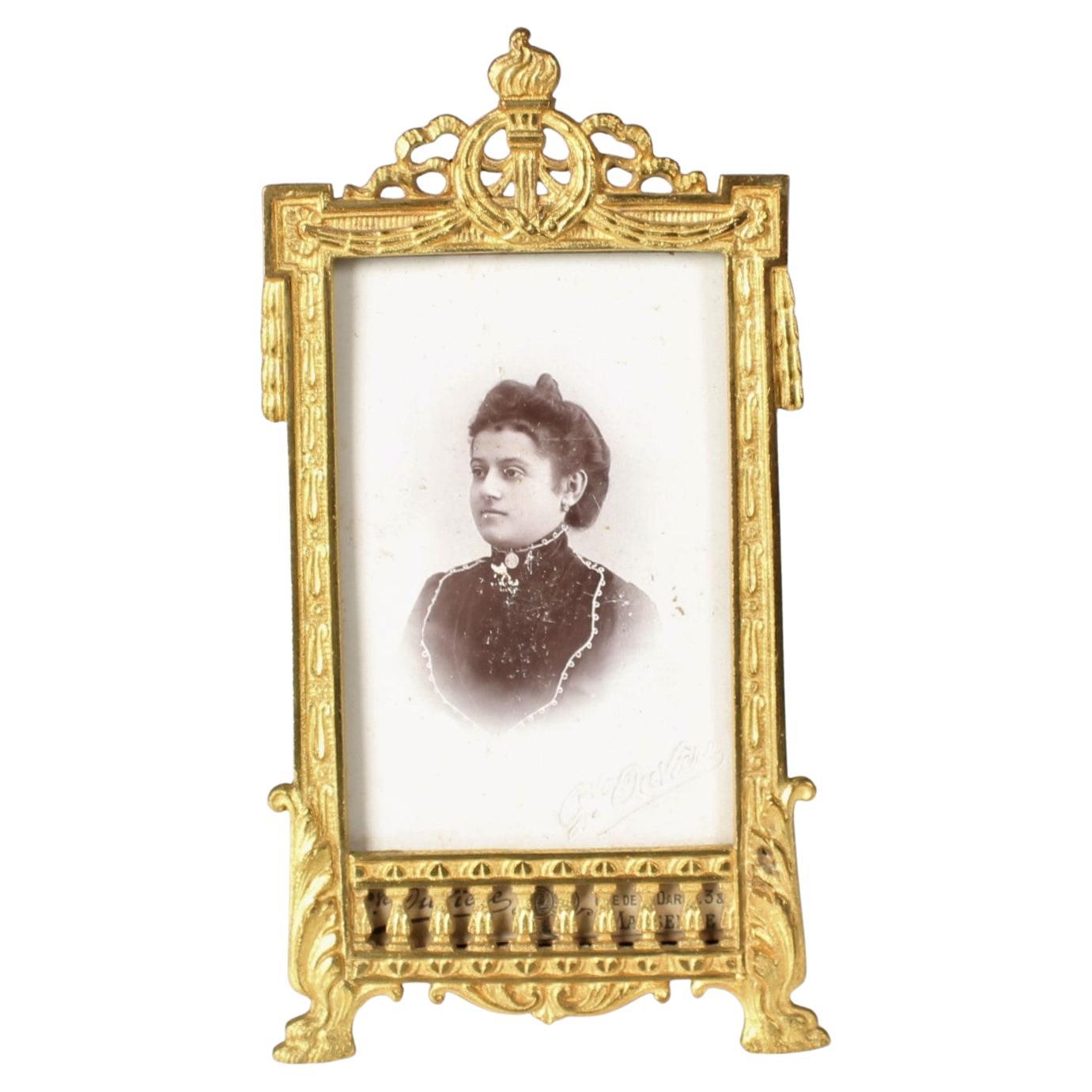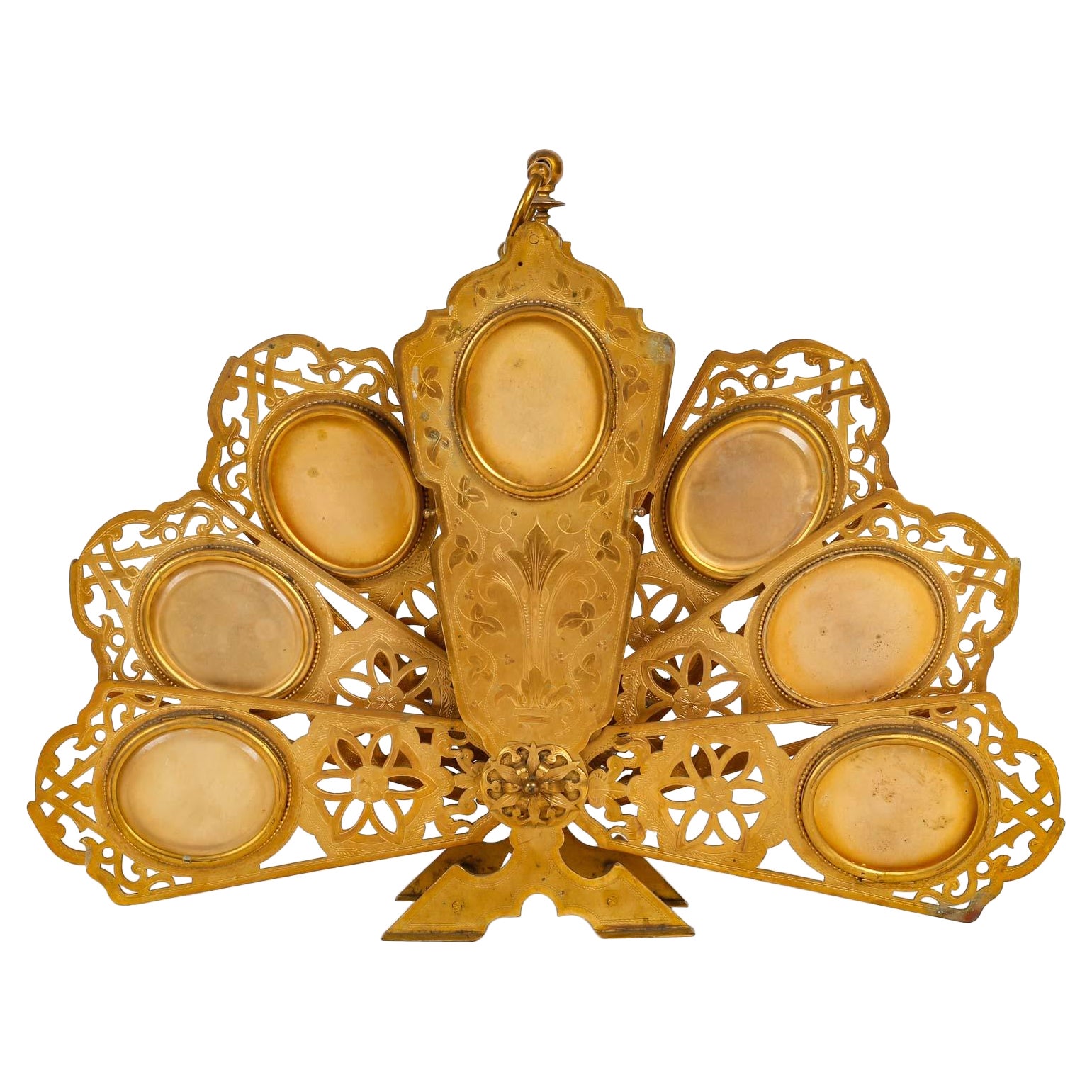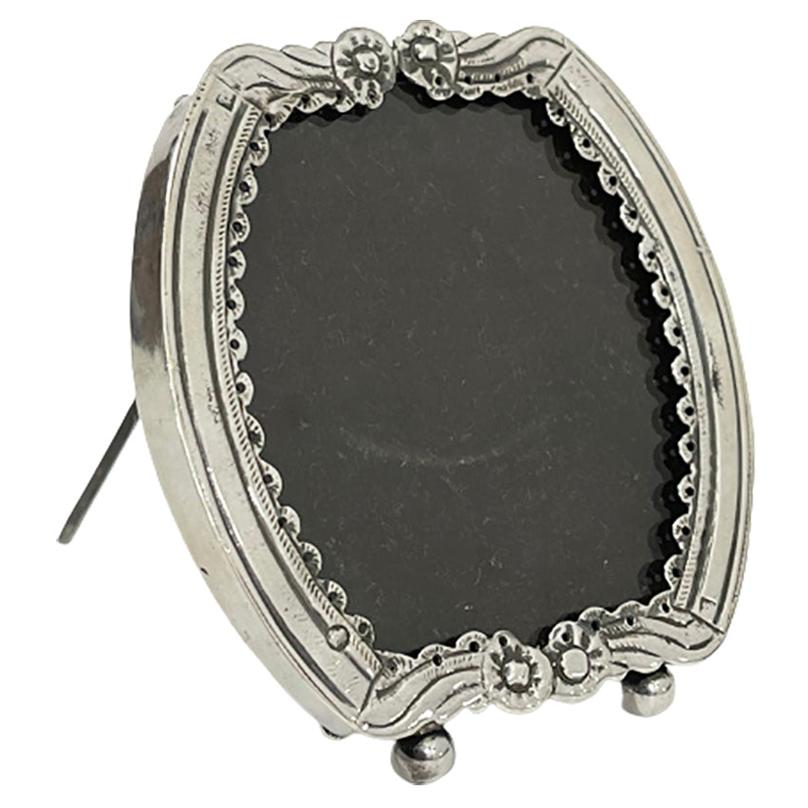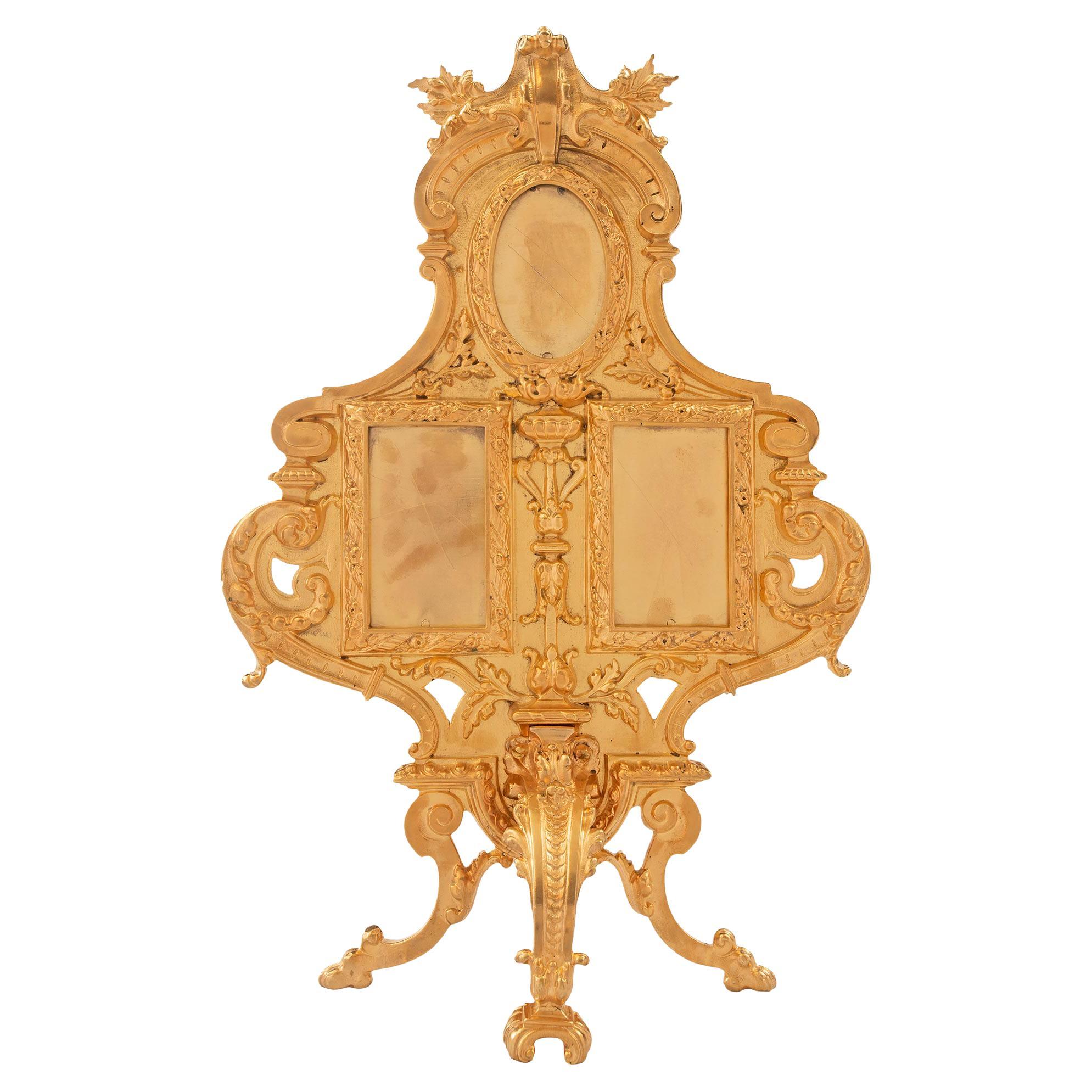Items Similar to Antique Ormolu & Agate Mounted Easel Photo Frame, 19th Century
Video Loading
Want more images or videos?
Request additional images or videos from the seller
1 of 22
Antique Ormolu & Agate Mounted Easel Photo Frame, 19th Century
About the Item
This is a beautiful antique ormolu and agate mounted easel photograph frame, circa 1880 in date.
The arched backplate features a wavy edge border having a pair of spring loaded arched doors enclosing five ovals for miniatures or photographs.
The ormolu frame with foliate engraved decoration.
Provenance:
Lady Elizabeth Prinfle Lady in waiting to Queen Victoria,
lived at Bonchurch, Isle of Wight.
It is a lovely piece which apart from its functionality is also a highly decorative item.
Condition:
In excellent condition, please see photos for confirmation.
Dimensions in cm:
height 25 x width 24 x depth 14.
Dimensions in inches:
height 10 inches x width 9 inches x depth 5 inches.
Our reference: A3076
- Dimensions:Height: 9.85 in (25 cm)Width: 9.45 in (24 cm)Depth: 5.52 in (14 cm)
- Materials and Techniques:
- Period:
- Date of Manufacture:circa 1880
- Condition:
- Seller Location:London, GB
- Reference Number:
About the Seller
5.0
Platinum Seller
These expertly vetted sellers are 1stDibs' most experienced sellers and are rated highest by our customers.
Established in 1983
1stDibs seller since 2012
1,204 sales on 1stDibs
Typical response time: 1 hour
Associations
LAPADA - The Association of Arts & Antiques Dealers
- ShippingRetrieving quote...Ships From: London, United Kingdom
- Return PolicyA return for this item may be initiated within 14 days of delivery.
More From This SellerView All
- Antique Ormolu & Agate Mounted Casket by Asprey, 19th CenturyLocated in London, GBThis is a superb antique gilt bronze and agate mounted casket by Asprey, Circa 1870 in date. The casket features a rectangular outline with domed lid which opens to reveal two clear glass scent bottles. It is stamped Charles Asprey, 166 Bond Street, Provenance: Lady Elizabeth Prinfle Lady in waiting to Queen Victoria, lived at Bonchurch, Isle of Wight It is a lovely piece which will make an unforgettable gift. Condition: In excellent condition having been beautifully cleaned in our workshops, please see photos for confirmation. Dimensions in cm: height 10.5 x width 12.5 x depth 7.5 Dimensions in inches: height 4 inches x width 5 inches x depth 3 inches Asprey was established in England in 1781 and founded as a silk printing business by William Asprey, it soon became a luxury emporium. In 1841, William Asprey's elder son Charles went into partnership with a stationer located on London's Bond Street. In 1847 the family broke with this partner and moved into 167 New Bond Street, the premises Asprey occupies today. From its central London location Asprey advertised 'articles of exclusive design and high quality, whether for personal adornment or personal accompaniment and to endow with richness and beauty the table and homes of people of refinement and discernment.' An early speciality was dressing cases. Asprey crafted traditional cases and designs, mostly in leather, suitable for the new style of travel ushered in by railways. The main competitors at the time were H.J. Cave & Sons. Asprey was recognised for its expertise when it won a gold medal for its dressing cases at the International Exhibition of 1862 but lost out to its rivals, H.J. Cave & Sons in 1867. The company consolidated its position through acquisitions. In 1859 Asprey absorbed Edwards, an award winning maker of dressing cases and holder of a Royal Warrant. The company also purchased the Alfred Club at 22 Albemarle Street, which backed on to the New Bond Street store and meant that Asprey now had entrances on two of London's most fashionable streets. In 1862, Asprey was granted a Royal Warrant by Queen Victoria. The Prince of Wales, later to be crowned Edward VII, granted another Royal Warrant. In 1953, for the coronation of Elizabeth II, Asprey paid homage with the Asprey Coronation Year Gold Collection, which featured a dessert, coffee and liqueur service in 18-carat gold and weighed almost 27 pounds. In April 1953, it went on show in the New Bond Street store and subsequently toured the United States. As the business grew, the company acquired manufacturing facilities and hired silversmiths, goldsmiths, jewellers and watchmakers including Ernest Betjeman, the father of the distinguished poet John Betjeman, one of the most highly regarded craftsman and designers of his day. In the twenties, commissions poured in from around the world, from American millionaire J. Pierpont Morgan to potentates such as the Maharaja of Patiala, who commissioned a huge teak travelling trunk for each of his wives in which each trunk was fitted with solid silver washing and bathing utensils with waterspouts of ornate tiger head and lined with blue velvet. Asprey cigarette cases became collectable amongst young sophisticates who delighted in its other modern products, including travel clocks, safety razors and automatic pencil sharpeners. Asprey Jewellery Asprey has a tradition of producing jewellery inspired by the blooms found in English gardens. Over the decades jewelled interpretations of flowers have evolved to include the Crown Daisy, Rose, Calla Lily and Lily Pad collections. The master diamond cutter Gabi Tolkowsky created the Asprey cut. The cushion cut gave Tolkowsky options for incorporating the Asprey "A" inscription around the edges of the stone. The result was the 61-facet Asprey cut, maximising light refraction to brilliant effect. The shape of the Asprey cut means that the cutting process can be done only by hand, unlike many other stones that involve machine cutting. Asprey Leather - the women's collection of clutches and handbags, such as those featured in the 1781 collection, come from crocodile, python and ostrich. The men's collection includes wallets, cardholders and travel watch cases crafted from lido, calf or alligator. Other items include the briefcases and backgammon boards. Asprey Silver - offers classic and whimsical contemporary silver pieces – such as the saltcellar fashioned to look like a cement mixer...Category
Antique 1870s English Decorative Boxes
MaterialsAgate, Ormolu
- Vintage Sterling Silver Photo Frame London 20th CBy Carrs of Sheffield 1Located in London, GBA superb decorative sterling silver photo frame by Carrs of Sheffield, with makers mark RC and hall marks for Sheffield 1996. Beautiful portrait or landscape frame decorated with...Category
1990s English Sterling Silver
MaterialsSterling Silver
- Antique Victorian Sterling Silver Photo Frame Dated 1894 33x26cmLocated in London, GBA superb Victorian sterling silver photograph frame by William Comyns, wuth hallmarks for London 1894. A beautiful portrait frame decorated with a decorative heart shaped aperture...Category
Antique 1890s Picture Frames
MaterialsSterling Silver
- Antique Victorian Sterling Silver Photo Frame William Comyns 1897 20x14cmLocated in London, GBA superb antique Victorian sterling silver photograph frame, with makers marks for the renowned silversmith William Comyns, and hallmarks for London 1897 Beautifully portrait fra...Category
Antique 1890s Picture Frames
MaterialsSterling Silver
- Antique Ormolu Mounted Serpentine Boulle Credenza, 19th CenturyLocated in London, GBThis is an important antique, Victorian, ebonised, ormolu mounted, and red Boulle cut brass marquetry serpentine credenza, circa 1870 in date. It is beautifully inlaid in cut bras...Category
Antique 1870s English Victorian Cabinets
MaterialsOrmolu, Brass
- Antique French Empire Revival Ormolu Mounted Desk, 19th CenturyLocated in London, GBThis is an exquisite French Empire Revival pedestal desk, circa 1880 in date. This desk has been beautifully crafted from flame mahogany. The top has a striking gold tooled black leather inset writing surface which has a decorative geometric inlaid satinwood and ebony border around it. It features beautifully cast gilded Ormolu mounts including angels, pharaonic herms above paw feet and swan escutcheons. It is further enhanced with male masks wearing nemes headress's on the sides, making it an incredibly imposing and impressive item of furniture. The desk features seven drawers for maximum storage, it is freestanding with a beautifully panelled back and comes complete with the original working locks and keys. This desk will soon become the centrepiece of your furniture collection, there is no mistaking the sophisticated quality and design and it is certain to enhance the style and elegance of any living area, bedroom, or reception. THE BOTANICAL NAME FOR THE MAHOGANY THIS ITEM IS MADE OF IS SWIETENIA MACROPHYLLA AND THIS TYPE OF MAHOGANY IS NOT SUBJECT TO CITES REGULATION. Condition: In excellent condition having been beautifully cleaned, French polished, waxed and releathered in our workshops, please see photos for confirmation. Dimensions in cm: Height 76 x width 150 x depth 80 Dimensions in inches: Height 29.9 x width 59.1 x depth 31.5 Empire style, is an early 19th century design movement in architecture, furniture, other decorative arts, and the visual arts followed in Europe and America until circa 1830. The style originated in and takes its name from the rule of Napoleon I in the First French Empire, where it was intended to idealize Napoleon's leadership and the French state. The style corresponds to the Biedermeier style in the German-speaking lands, Federal style in the United States and to the Regency style in Britain. The previous style was called Louis XVI style, in France. The Empire style was based on aspects of the Roman Empire. It is the second phase of neoclassicism which is also called "Directoire", after a government system. Furniture typically had symbols and ornaments borrowed from the glorious ancient Greek and Roman empires. The furniture was made from heavy woods such as mahogany and ebony, imported from the colonies, with dark finishes often with decorative bronze mounts. Marble tops were popular as were Egyptian motifs like sphinxes, griffins, urns and eagles and the Napoleonic symbols, the eagle, the bee, the initials "I" and a large "N." Gilded bronze (ormolu) details displayed a high level of craftsmanship. Flame mahogany Thomas Sheraton - 18th century furniture designer, once characterized mahogany as "best suited to furniture where strength is demanded as well as a wood that works...Category
Antique 1880s French Empire Revival Desks and Writing Tables
MaterialsOrmolu
You May Also Like
- Antique Picture Frame, Brass Easel, Late 19th Century, FranceLocated in Greven, DEUnusual picture frame made of heavy, high quality brass. The picture frame is manufactured as a canvas on an easel. The picture is firmly moun...Category
Antique Late 19th Century French Picture Frames
MaterialsBrass
- 19th Century EaselLocated in Napa, CAAppx 19th CenturyCategory
Antique 19th Century Picture Frames
MaterialsWood
- Beautiful Antique Picture Frame, Photo Frame, Brass, Late 19th CenturyLocated in Greven, DEBeautiful picture frame with rich ornaments from the late 19th century with antique photo. Picture Size: 6 x 9 cm.Category
Antique Late 19th Century Picture Frames
MaterialsBrass
- Gilded Bronze Photo Frame, 19th Century.Located in Saint-Ouen, FR" Gilded bronze photo frame, 19th century. " Frame, family photo holder forming a fan in gilded bronze, 19th century antique, Napoleon III period. h: 25cm, l: 34cm, p: 6cmCategory
Antique 19th Century French Napoleon III Picture Frames
MaterialsBronze
- Dutch 19th Century Small Silver Photo FrameLocated in Delft, NLDutch 19th century small silver photo frame A Dutch small standing silver photo frame in mirror image 19th Century. Dutch silver photo f...Category
Antique 19th Century Dutch Picture Frames
MaterialsSilver
- French 19th Century Louis XVI Ormolu FrameLocated in West Palm Beach, FLA uniquely shaped and most elegant French 19th century Louis XVI ormolu frame, that accommodates three pictures. The frame is raised by four curved le...Category
Antique 19th Century French Louis XVI Picture Frames
MaterialsOrmolu
Recently Viewed
View AllMore Ways To Browse
Antique Furniture Photos
Arched Frame
Antique Border Frame
Antique Frames Borders
Antique Frames And Borders
Dating Antique Frames
Pair Of Antique Frames
Antique Oval Frames
Antique Oval Frame
Oval Antique Frames
Antique Pair Frames
Dating Antique Photographs
Antique Photo Frames
Photo Frames Antique
Antique Framed Photos
Antique Framed Photo
Framing Antique Photos
Oval Photo
